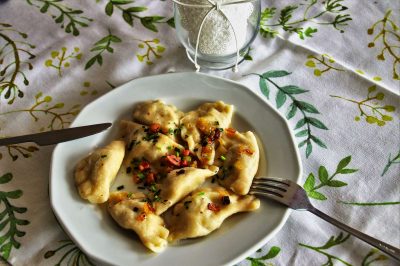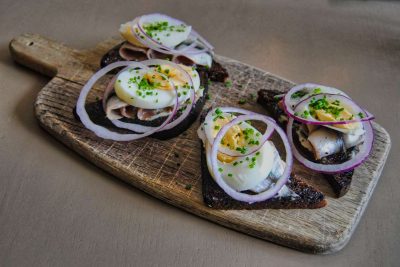Today we are going on a culinary journey through Romania, where we will introduce you to Romanian cuisine and traditional Romanian food. You’re guaranteed to get your fill here, as we’ll introduce you to the most delicious appetizers, soups, main dishes and desserts in turn. You will notice how diverse Romanian cuisine is and that you can cook many dishes relatively easily.
Over time, Romanian cuisine has experienced different influences, especially Turkish and Hungarian cuisine have left their mark. If you are also interested in other Eastern European cuisines, please click here to get to our overview. Here we go with the most delicious Romanian specialties!
Cold appetizers (Antreuri reci)
Romanian cuisine is rich in appetizers, with hot and cold variants. The following classics should not be missing at any Romanian feast.
Zacuscă
Zacuscă is one of the most popular appetizers of Romanian cuisine. It is a mush usually made from peppers or eggplants, but often from mushrooms or tomatoes. The vegetables are usually roasted or boiled, chopped, then minced and seasoned with spices and herbs. There is no single recipe for zacuscă, as each family knows a different way to prepare the appetizer. Often other things like fish or beans are added. In the end, you get a mush that is usually served on a slice of baguette, similar to Italian bruschetta, in other words.
Salată de vinete
A Romanian meal without Salată de vinete? Hardly imaginable! The popular Romanian dish is traditionally prepared by cooking or roasting an eggplant directly on the stove. However, many also bake them in the oven. By cooking on the stove, the eggplant gains a slight smoky flavor. Then the eggplant is chopped and seasoned with various spices. Add a dash of oil and you have a simple but delicious appetizer! This is often served with bread or chopped raw onions.
Salată de icre de crap
Somewhat more difficult to prepare and also expensive is the Salată de icre de crap. It is a frothy creme made from the roe of carp. Oil and a squeeze of lemon, as well as capers and possibly scallions, are the other ingredients of this light appetizer that is mainly served on holidays. The ingredients are whipped into a froth with oil, just like mayonnaise, and many add a bit of semolina. The beauty of Salată de icre is its versatility. It can either be served on bread, on a slice of lemon or simply in a bowl as a side dish.
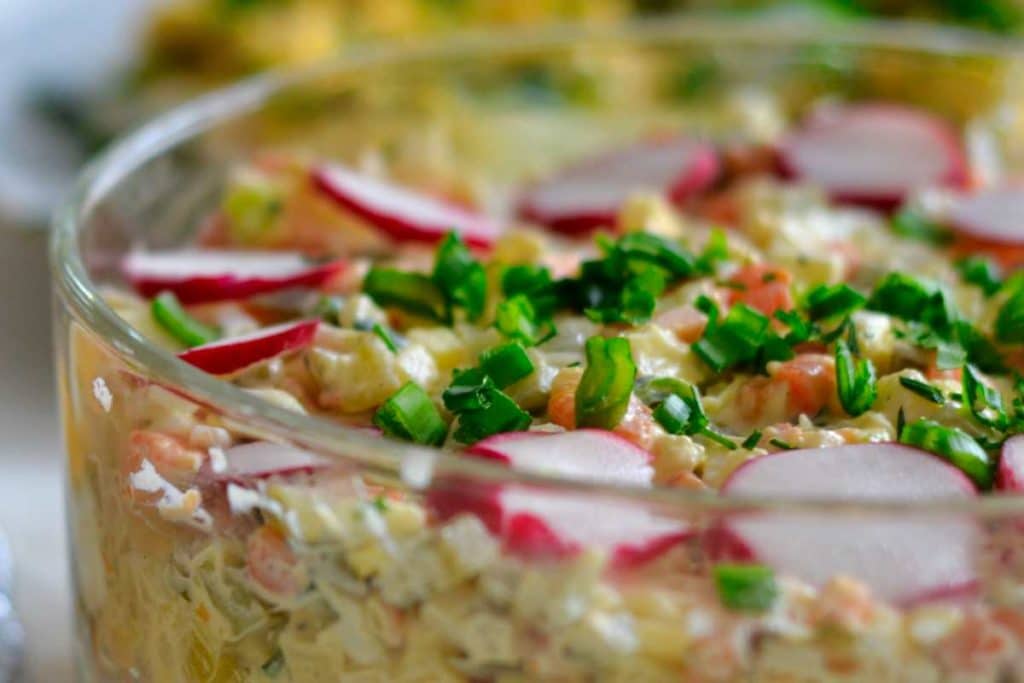
Salată de boeuf
Salată de boeuf brings a touch of French sophistication to Romanian cuisine. It resembles the Russian oliwje and the Polish sałatka jarzynowa and is a real calorie bomb compared to the Salată de icre de crap. The hearty salad contains beef, beans, potatoes, carrots, pickles and, most importantly, lots of mayonnaise. The ingredients are cooked (except for the mayonnaise and pickles) and then cut into small cubes. Seasoned with salt and pepper and add dill to create a delicious appetizer that still tastes good on the second day and that we can recommend for the next barbecue.
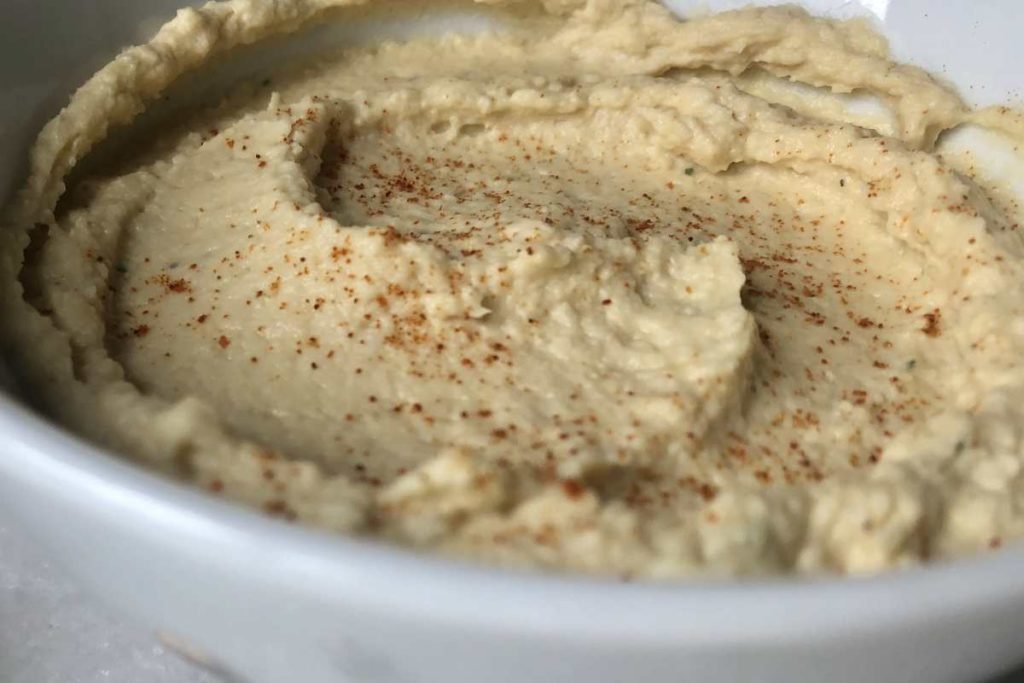
Fasole batută
You’ve already noticed, in Romania they have a penchant for mush and creme. And fasole batută are no exception. To prepare the paste, cooked beans are mashed, mixed with oil, and then often add roasted onions refined with noble sweet paprika. Depending on preference, garlic, chili or lemon juice can be added – ready is the simple appetizer, which is also great as a dip!
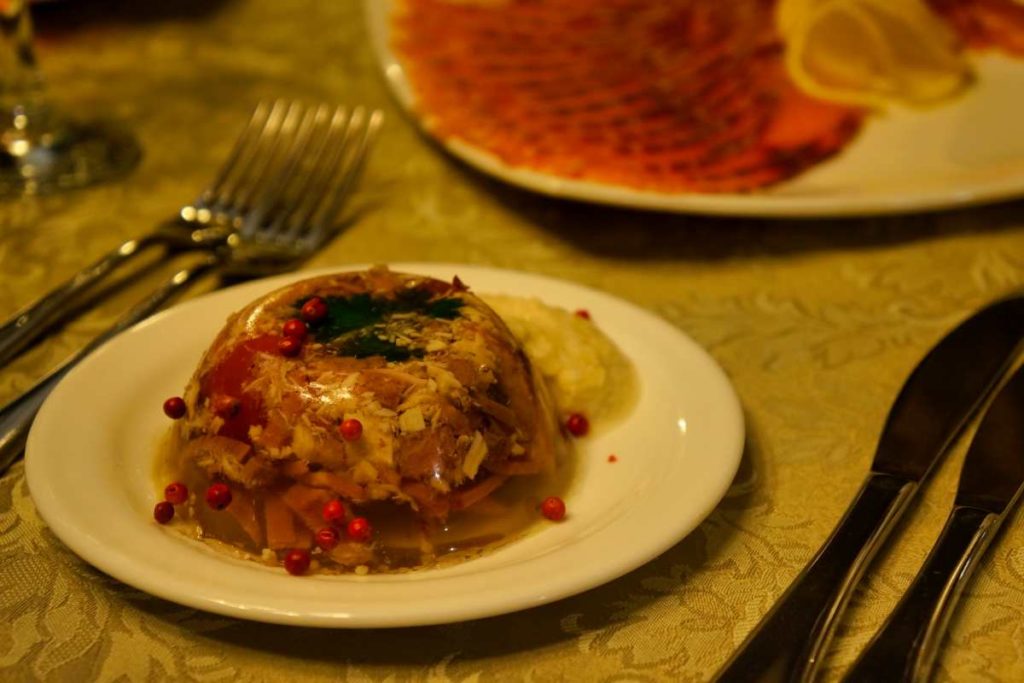
Piftie de cocoş sau de porc
Simple, but delicious is this Romanian classic. A rooster or a large piece of pork is first soaked in water for several hours and then boiled. Then bay leaves, pepper and garlic are added to the pot. The whole thing simmers for a while, then you just wait and let the dish cool down. Now you can eat the chicken or pork either with or without the liquids, the only important thing is that the appetizer is served cold. The liquid, basically a greatly reduced soup, contains a lot of gelatin and gels when chilled. It is essential to keep the dish in the refrigerator, otherwise the solidified liquid will liquefy again.
Warm appetizers (Antreuri calde)
Slowly we are approaching the main courses, but before that you should try two warm appetizers, which are real Romanian specialties and very easy to prepare.
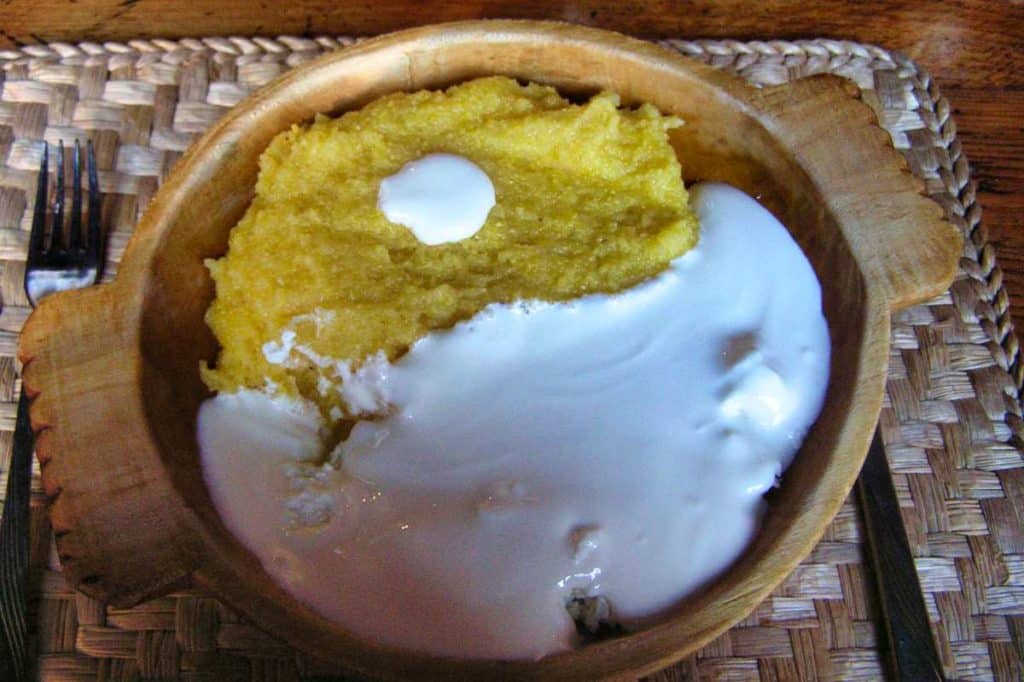
Mămăligă
Mămăligă is one of the absolute classics of Romanian cuisine. It is a corn semolina polenta, which is also popular in many other countries in the region. In the past, the Mămăligă was considered a poor man’s food, but this has now changed. The dish is quite easy to prepare and is not only a delicious appetizer, but also recommended as a side dish for meat dishes. You just need to cook corn grits in a pot of salted water, stirring constantly so that no lumps form.
If you want to do it like the Romanians, take the top of a Christmas tree, which is freed from its bark and dried (but a spoon will also do if there is no Christmas tree at hand). The cornmeal polenta is typically cooked for a very long time and then turned out onto the table. This creates a kind of cake that can then be cut into smaller portions, traditionally with a thread. The Mămăligă is also often topped with feta cheese and/or served with sour cream.
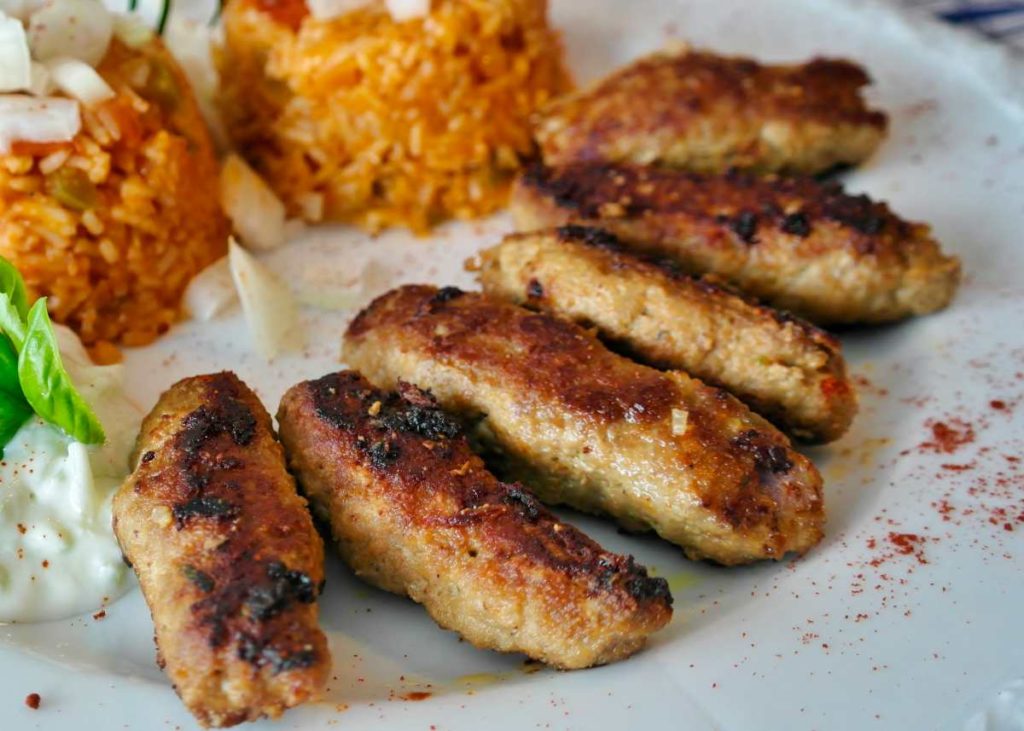
Mici la grătar
From the picture you can already see it clearly: Mici la grătar are small, grilled minced meat rolls. They are said to have been “invented” in a Bucharest restaurant back in the 19th century. The similarity to Ćevapčići is obvious, but there are a few differences, especially in terms of ingredients. The important ingredient of mici (“little ones”) is mujdei, a Romanian garlic sauce. But lemon juice, savory or coriander are also used. Many families have their own recipe and mici la grătar never taste the same, but different in every part of the country, but is always served with fresh white bread and mustard. You can find them in almost every market and mici la grătar is a great snack for in-between meals, which goes well with a beer.
Soups and sour soups (Supe si ciorbe)
Basically, Romanian distinguishes between a “normal” soup and a ciorbă, which is a soured soup.
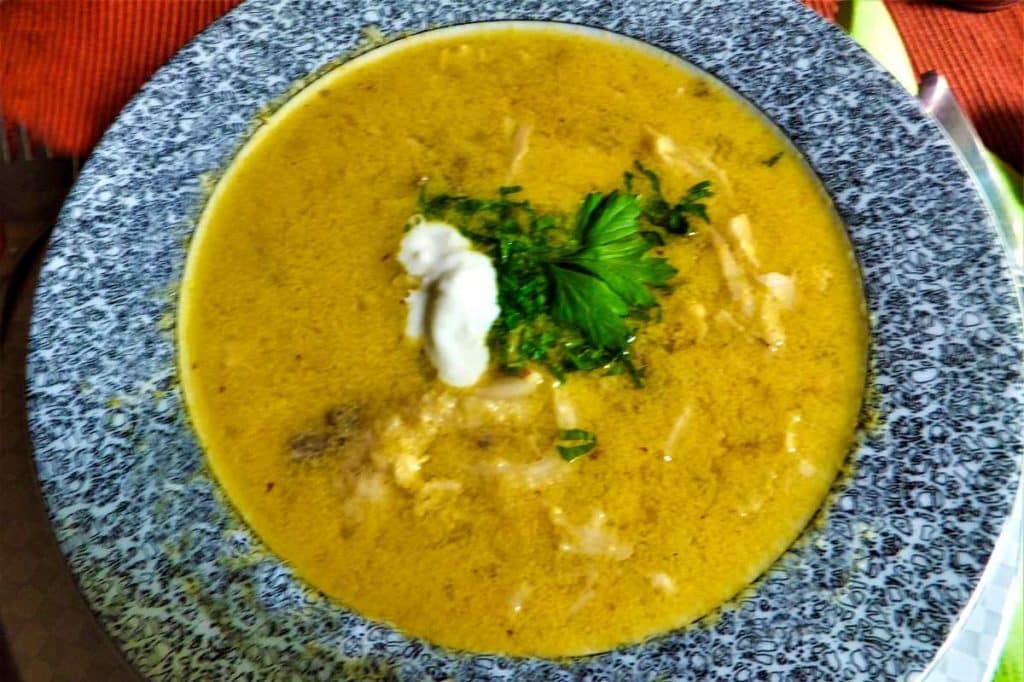
Ciorbă de burtă
One of these soured soups is the Ciorbă de burtă, behind which is hidden the not really appetizing English name tripe soup. If you’re not into offal, you’d better read on. To all others, Romanian tripe soup is originally of Turkish origin and has a beautiful yellow color. Cooked with lots of cream, egg yolk, celery and leek and vinegar, tripe soup is tastier than you might think and is perhaps the best known Romanian sour soup.
A panacea for hangovers
Ciorbă de burtă is often served for late breakfast after all-nighters. Just like after wedding parties, which in Romania last all night, if not several days. Rich, warm and sour, it reawakens the spirits of tired guests and provides a good basis for continuing the party.
Supă sau ciorbă de perişoare
Ciorbă de perișoare could already rather meet the western taste. Here, small balls of meat, rice, breadcrumbs and spices are cooked together with roasted vegetables such as tomatoes, peppers or celery in a broth and then served with a blob of sour cream or an egg yolk. Before that, however, the soup is soured if you want it to be a Ciorbă variety. For this purpose, you can use sauerkraut juice, bread liquor, green unripe mirabelles, plums or grapes. If you like it spicy, you can add a chili pepper to the meatballs. There are also countless variations.
Ciorbă de salată verde cu afumatură
Salad or soup for appetizer? Why not both? This unusual combination comes from Transylvania and includes several types of lettuce, a lot of bacon, garlic as well as dill, yogurt and a dash of milk. In addition, many also use a small-cut omelet. The bacon is often smoked before cooking, which gives the soup a special flavor. In the past, salad soup was most popular in the spring, but now it is cooked all year round.
Main courses (Feluri principale)
Some of the starters were quite hearty, but wait and see what awaits you for the main course. Romanian food is overall very substantial and Romanian dishes are characterized on the one hand by down-to-earthness, but there is no lack of a certain finesse.
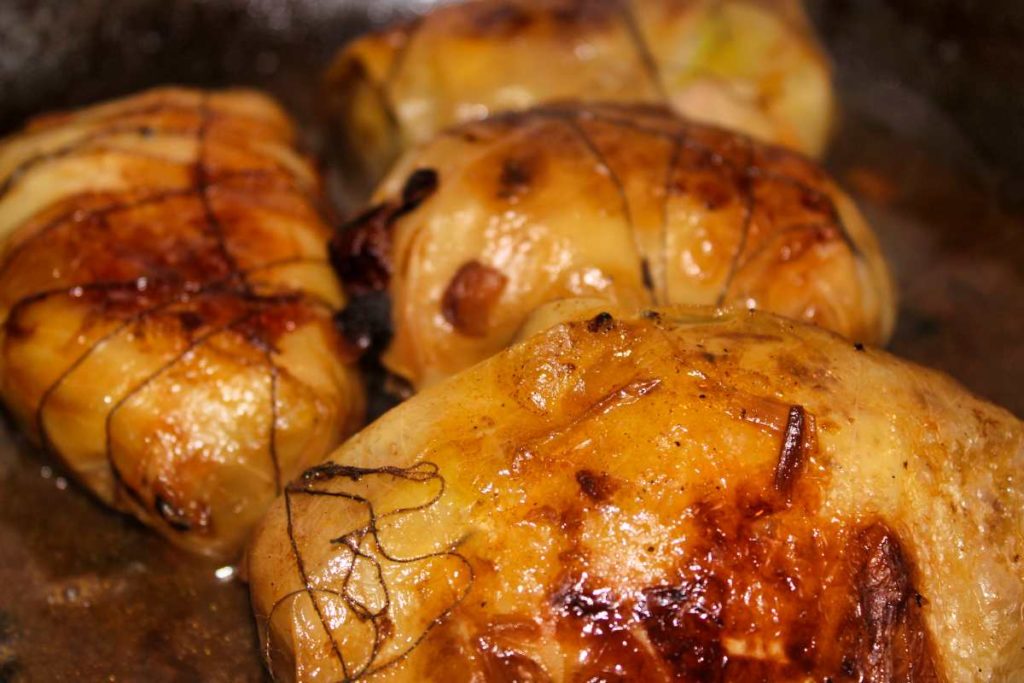
Sarmale in foi de varză dulce sau murată
Cabbage rolls or cabbage wraps are known in many European cuisines and Romanian cuisine is no exception. The name sarmale is derived from the Turkish word for “roll,” and many words in Romanian are of Turkish origin. Usually popular especially in Wallachia and Transylvania, this Romanian specialty uses pork to fill the rolls, which is mixed with rice and onions. The roulades are wrapped in cabbage leaves or sauerkraut leaves. In Romania, you put the whole cabbage heads, thus you can fill the leaves. The wraps are cooked in the oven together with chopped cabbage and bacon, many also take sauerkraut as a garnish. They are usually accompanied by a delicious Mămăligă and many serve the sarmale at Christmas or Easter.
Sarmale in foi de viţă
The next dish is also wrapped. Instead of pork, however, beef with onions is used here, and in addition, not cabbage leaves but vine leaves are used, which gives this Romanian specialty a sweeter note. The whole thing is then cooked in a tomato sauce. Many people in Romania also eat this form of sarmale as an appetizer, but it can also be served with a blob of sour cream as a main course.
Mâncare de prune
“Plum food” is the translation of this unusual Romanian classic. The vegan dish consists of chopped onions sautéed in oil. Similar to a bechamel sauce or a roux, flour is now added and deglazed with white wine. Then dried plums and some water are added and the dish is simmered – ready is the basis of this quick dish, which is usually served on boiled pasta, with white bread or Mămăligă.
Praz cu măsline
Praz cu măsline is also suitable for vegetarians and vegans. Here, too, onions are first sautéed in oil, then add chopped peppers and a little garlic and salt, oregano, bay leaves and other herbs. Now come the two most important ingredients: Leeks and black olives! Then you add some tomato sauce and let it simmer for a few minutes. The result is a light and tasty main course that has an unusual flavor due to the leeks and especially the olives.
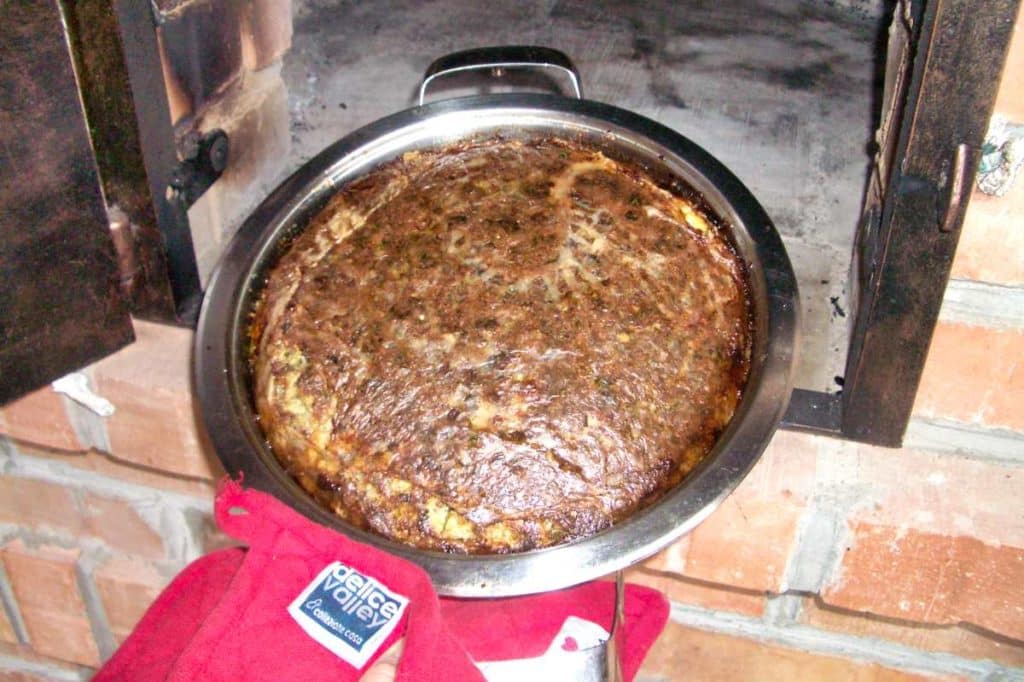
Drob de miel
There is another Romanian dish besides ciorbă de burtă that uses organs. The classic Romanian Easter dish consists of chopped lamb offal, onions, eggs, sour cream and spices and is baked in the oven similar to a meatloaf. If you are not a fan of offal, you can also use regular lamb. The dish is also prepared at Easter, because in addition to the lamb, the eggs are a symbol of Jesus and the resurrection from the dead.
Ciulama de pui
Ciulama de pui is a Romanian chicken dish that is relatively easy to prepare. For this, first chicken thighs are cooked, then carrots, onions and other vegetables as desired are added to the cooking pot. The resulting chicken broth is then removed and mixed with a roux, which is deglazed with the chicken broth, to form a thick sauce. The resulting sauce is then served with the chicken thighs and vegetables. It goes well with pasta or a Mămăligă.
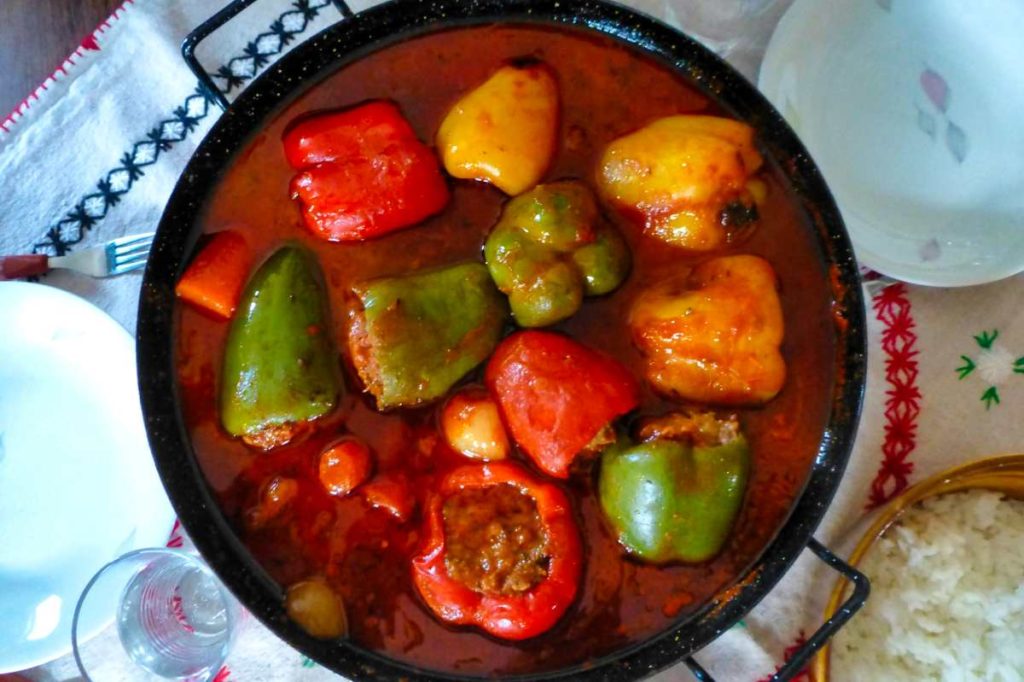
Ardei umpluţi
Stuffed peppers have found their way from Hungarian cuisine into the Romanian cooking pot and are popular all over the country. First you have to fry minced meat together with onions. Now you add some grated carrots, rice, broth, tomato paste and spices. When it is done, hollow out the peppers and fill them with the mixture, then let them cook in the pot for a while. If you prefer to cook a vegetarian version, you can use vegetables instead of minced meat.
Iahnie de fasole
Iahnie de fasole is a bean dish that is popularly served on the Romanian national holiday, the first of December. The dish is believed to be of Bulgarian or Turkish origin and easy to prepare. The stew consists of white beans, onions, garlic, broth with tomato paste, oil and bay leaves cooked together. Some sour cream is also used here, the stew is often served together with sausage, meat and pickled cucumbers, sometimes with gogonele, pickled green tomatoes.
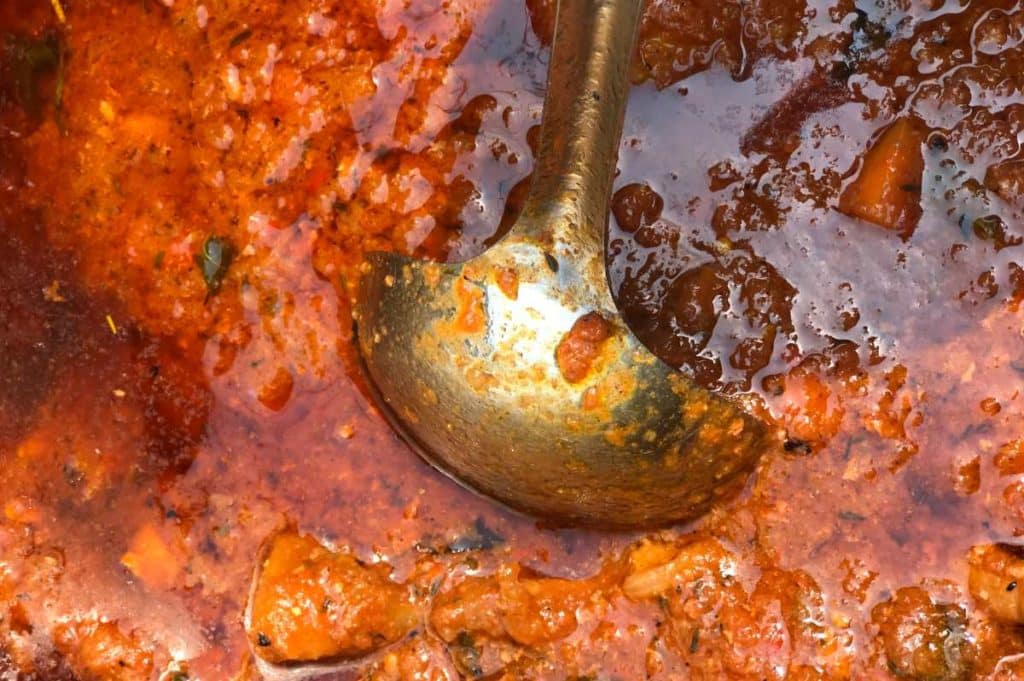
Ostropel de pui
Besides the many dishes that have made it into Romanian cuisine from neighboring countries, there are also those that are definitely of Romanian origin. One of these Romanian specialties is ostropel de pui. For this, chicken meat is cooked together with vegetables, then strained or pureed tomatoes are added and the whole thing is left to simmer until the sauce is significantly reduced. Ostropel de pui is usually served with Mămăligă.
Desserts (Dulciuri)
It’s hard to imagine being hungry after such a rich Romanian meal, but there’s always room for something sweet. And in Romania there is a whole range of sweet delicacies that we would like to introduce to you here.
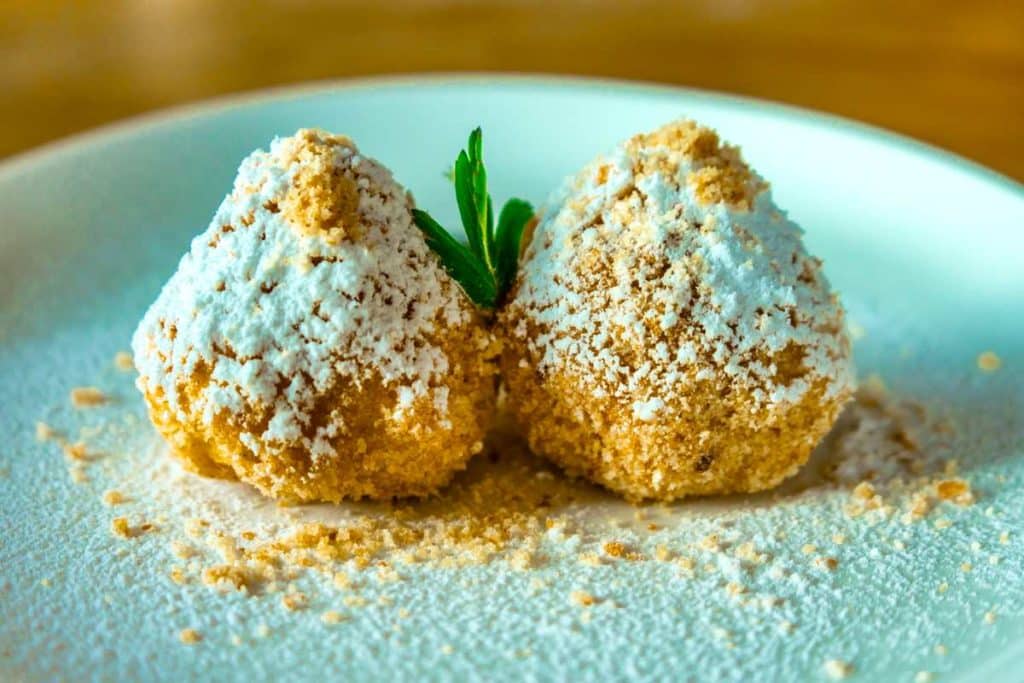
Papanaşi
Papanaşi are cottage cheese dumplings that contain cottage cheese as well as breadcrumbs, flour (important for binding) and a pinch of baking powder. These balls are then fried briefly and usually served with fruit (often blueberries) and whipped cream (cu smântană).
Colţunaşi cu branză
In terms of appearance, Colţunaşi resemble Polish pierogi and the idea of wrapping something in dough and then cooking it apparently came up in many cultures (see Maultaschen or ravioli). Colţunaşi in Romania are filled with cheese curds, spread with a little egg yolk and then baked in the oven. But you can also cook them and if you like it unorthodox, you can fill them with fruits.
Brânzoaică
Brânzoaică are a kind of small rolls made of yeast dough filled with cheese. The yeast dough is filled with cottage cheese, then possibly spread with honey, egg yolk or sour cream and then baked in the oven. The shape is important, because traditionally the brânzoaică are folded like an envelope. The Brânzoaică are then usually sprinkled with powdered sugar and are extremely juicy.
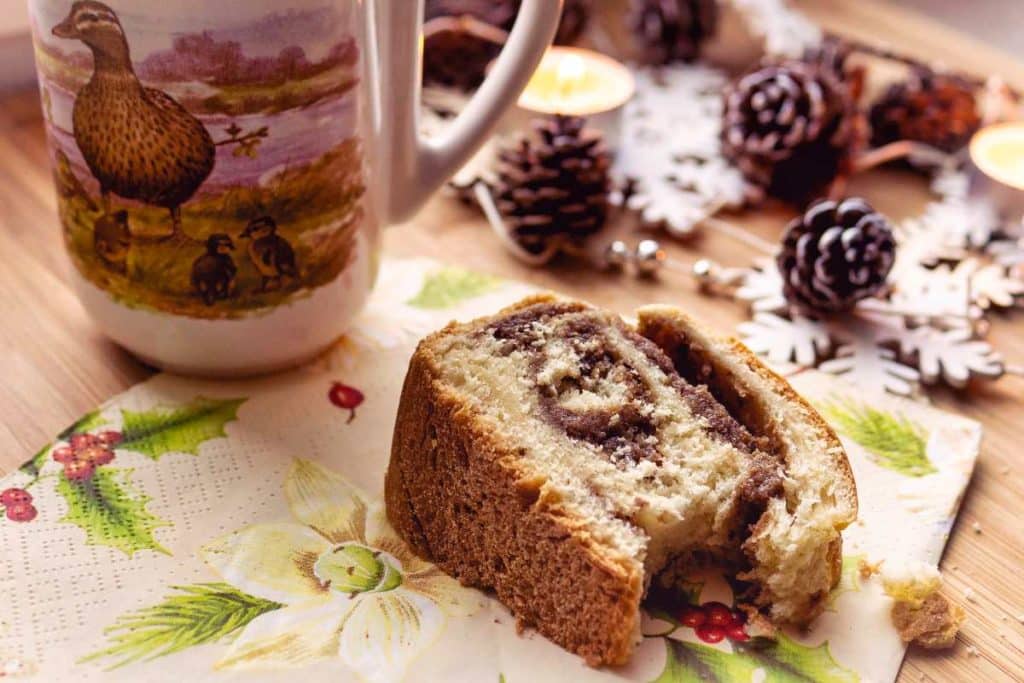
Cozonac cu nuci
Cozonac cu nuci is a classic nut plait known also in Western Europe. It is especially popular at Christmas and, in addition to the dough, it contains a lot of chopped walnuts, which are rolled up together with the dough, creating the classic nut plait. Baked in the oven in this way, the result is a moist cake that can be kept for several days.
Lapte de pasăre
Lapte de pasăre are a relatively light, snow-white dessert. Lapte de pasăre can be translated as “bird’s milk” and this dish is also known in Polish cuisine, but is prepared quite differently, in south German cuisine it is known as “snow balls”. To prepare this delicacy, small dumplings of beaten egg whites must be cooked in milk. Then egg yolk is mixed with vanilla and sugar and also boiled together with milk. This creates a delicious vanilla sauce that goes wonderfully with the bird milk.
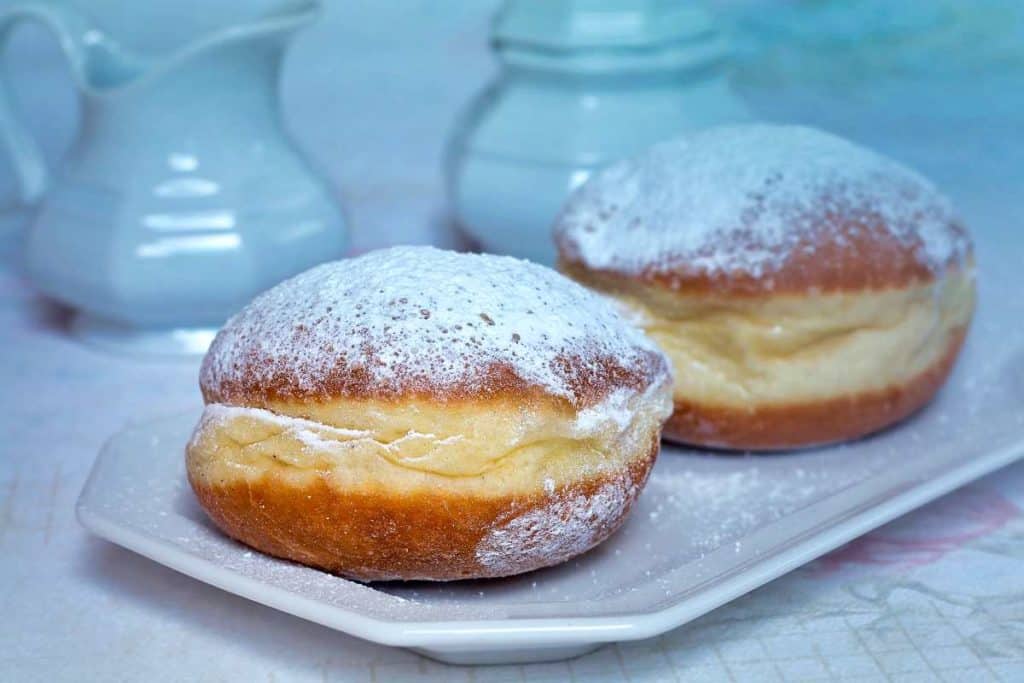
Gogoși
Gogoși are small yeast dough balls fried in fat, which are also found in similar form in other European cuisines. They are usually sprinkled with powdered sugar and often contain a filling. There are no limits to your imagination, you can use chocolate, jam or even cheese, depending on your taste, to create your Gogoși.
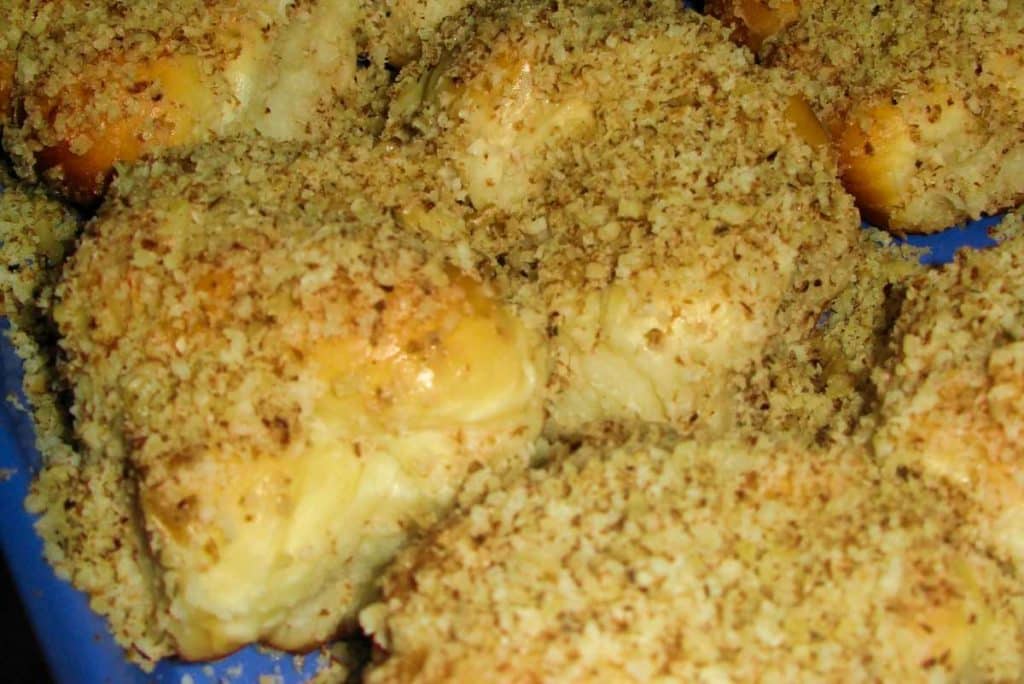
Mucenici moldovenesti
“Moldavian Martyrs” is the curious translation of this specialty, also known as Sfințișori (“Little Saints”). Traditionally, this dessert is made on March 9, the day of the 40 martyrs. This day commemorates 40 believers who fell victim to the persecution of Christians on this day in what is now Turkey. Traditionally, this involves twisting small strings of sweet yeast dough with each other and then folding them in the shape of the number 8 (which represents immortality). The Sfințișori are then baked and immediately after being removed from the oven, they are brushed with honey and sprinkled with chopped nuts.
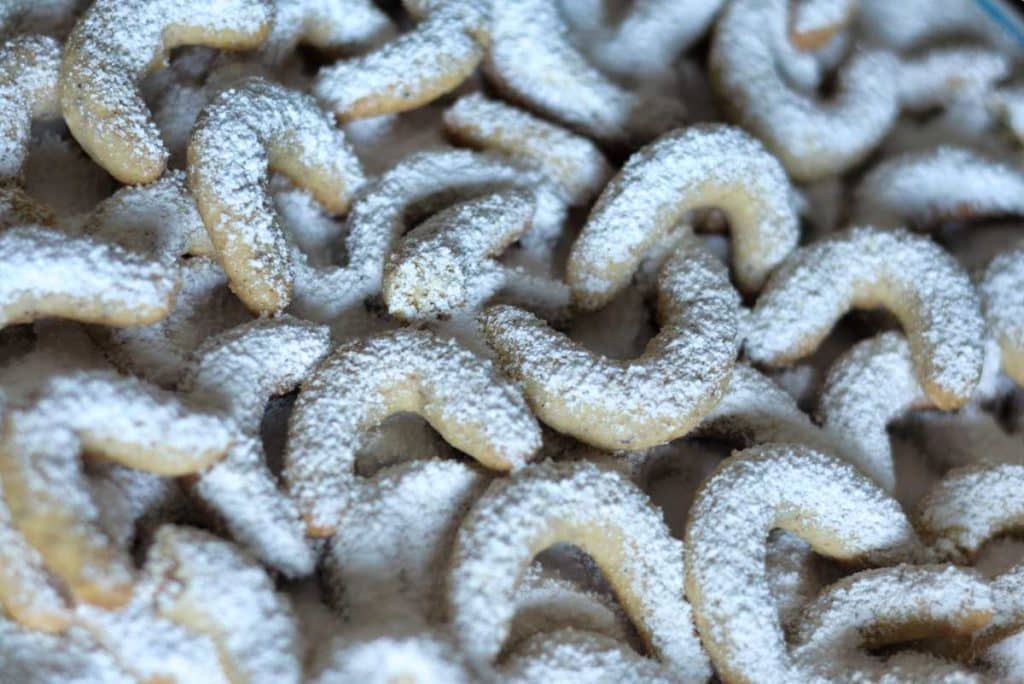
Cornuleţe cu nucă
As you have probably noticed, many Romanian desserts use nuts. This is also the case with Cornuleţe cu nucă, which can be made in different shapes. Sometimes they resemble the vanilla crescents known in Germany, sometimes they are more like small croissants. The only important thing is that, in addition to dough, lots of nuts are used in the preparation and the baked delicacies are then sprinkled with lots of powdered sugar.
Pască
The word Pască is used in other spellings in other countries and always refers to an Easter cake. In Romania, this cake is prepared from yeast dough, to which cheese, eggs, sour cream, sugar and raisins are added according to taste. Due to its characteristic yellow color, it symbolizes the sun, which in turn is emblematic of the resurrection at Easter. The rising of the yeast dough can also be seen as a Christian symbol. No matter what you think about these theories, Pască are above all delicious and easy to prepare!
Savarină
If you want to make a real savarină, you’ll have to put in a lot more work. The dish originated in France and is closely related to the well-known baba au rhum. There are numerous variations of this Romanian specialty, which is usually made with sanko or yeast dough and often has the shape of a bagel. However, the characteristic feature is that after baking, the cake is soaked in alcohol (usually rum). It is then served with cream and fruit, which is let into the hole in the middle.
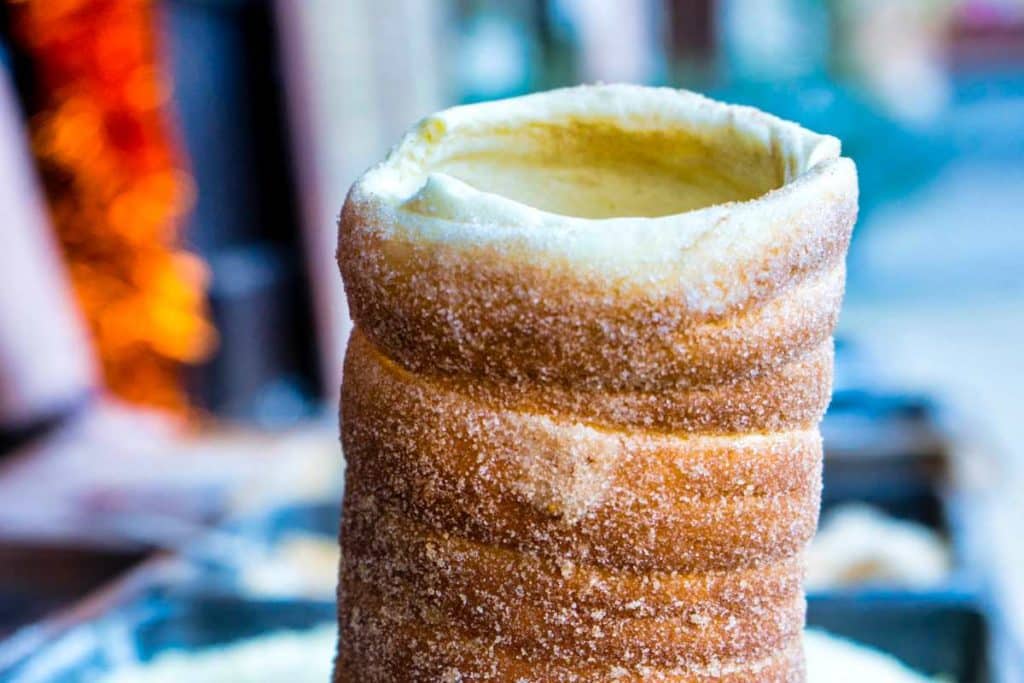
Colac secuiesc (kürtőskalács)
If you thought that this spit cake originally came from the Czech Republic or Hungary, you are probably wrong. It most likely originated in Transylvania, where it was traditionally baked on important occasions, usually not in the oven, by the way, but over an open fire. The dough is carefully wrapped in thin strips over a special tool that looks a bit like a kebab skewer. It is then coated with butter and rolled in sugar or nuts, according to taste. Then it goes over the fire, turning the skewer to brown it evenly and the sugar forms a glazed layer. Many then turn it again in sugar so that a light layer of crystals is formed.
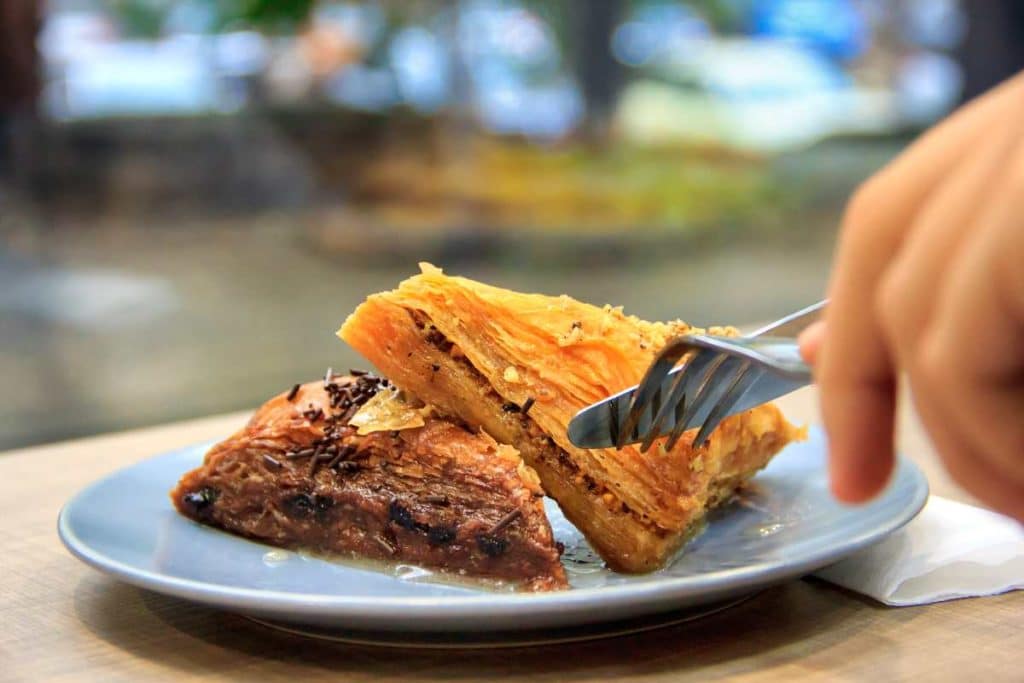
Baclava cu nuci
Baklava is one of the most popular oriental sweets and found its way to Romanian cuisine via the Ottoman Empire. The small delicacies consist of several thin layers of puff pastry filled with walnuts, which are widely available in Romania. The Romanian version contains much less sugar than the Turkish one. Therefore, it is also more digestible and you can and will treat yourself to a second piece. Surely you already know this Romanian specialty, which marks the end of our culinary journey through Romania.
Book recommendations Romanian food
No products found.
This classic Romanian cookbook contains more than 100 recipes with detailed descriptions and nice pictures
No products found.
This book has another approach and includes stories about Romania, so don’t just expect recipes, but also funny and interesting stories about the country.
How did you like our culinary journey through Romania? Do you already know the Romanian cuisine and what is your favorite traditional Romanian food? Feel free to let us know and write us a comment. Feel free to follow us on Facebook or Pinterest to stay up to date with the latest articles.
Many thanks at this point to Sanda Wilhelm for the many helpful tips!


